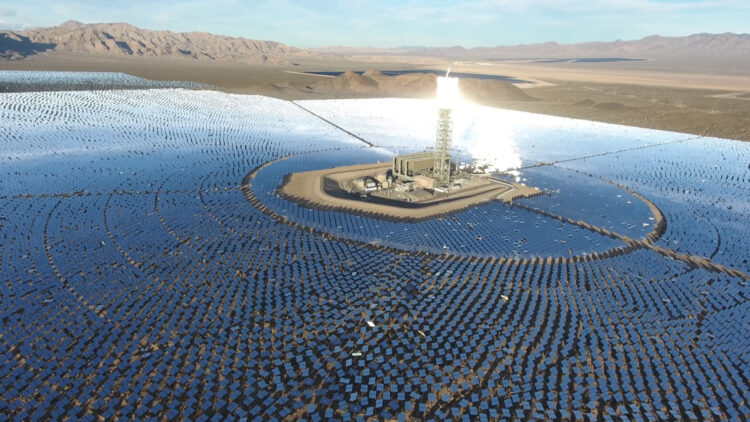In the heart of Nevada, something special has caught the attention of the global community, and that is an enigmatic 300-acre circular formation. This is not only about its eye-catching design but for its power-generating abilities. The Crescent Dunes Solar Energy Project promises a groundbreaking way of generating power—about 500,000 megawatts—and is stimulating renewable energy.
The Crescent Dunes CSP project in the United States was the first tower CSP with full-scale thermal energy storage, measuring 110 megawatts. (The distances of the solar field surrounding the tower receiver have optical limits above roughly 150 MW.) The startup SolarReserve, located in RocketDyne, created it and obtained a PPA to provide NV Energy in Nevada with a novel type of dispatchable solar.
How the Crescent Dunes work: An unusual circle of mirrors and melted salt
Crescent Dunes is tackling the issue of electricity storage uniquely. Instead of boiling water directly, a salt reservoir is melted by solar heating, and the molten salt is then utilised to boil water through a heat exchanger. After cooling, the salt that is still liquid is put back into the reservoir to reheat. When the sun isn’t shining, production can be smoothed out for ten hours thanks to the hot-salt reservoir’s capacity to continuously boil water for electricity.
Under computer control, more than 10,000 mirrors are aimed onto a tower that is around 200 meters (656 feet) high. Pipes convey the molten salt to be heated. After leaving, the salt is stored at a temperature of about 1,050 degrees Fahrenheit in a reservoir. This salt is passed through a heat exchanger to create superheated steam, which rotates a turbine to produce energy. 110 megawatts is the nameplate plant’s capacity, according to Atlas Obscura.
This melted salt is a game-changer in the renewable energy resource context and solar energy because heat is stored for later use, compared to the traditional solar energy generation whereby, if there is no sunlight or if the sun sets, it is at a disadvantage. Consistent power generation is made possible by this storage capacity, which is difficult for many renewable energy sources that depend on sporadic natural events.
From hope to obstacles: Crescent Dunes’ struggles
Unfortunately, this enigmatic 300-acre circle in the middle of the desert has also been associated with challenges, just like any other invention and project that is developed. It was in 2011 when the project was developed and constructed and started functioning in the year 2015. The goal is and was to supply electricity at an affordable price by utilising renewable solar energy (sunlight).
It should come as no surprise that the plant has operational challenges, primarily related to plumbing problems when handling the highly hot and corrosive molten salt, given its size and state-of-the-art equipment. It was unfortunate that in 2019, the corporate owners declared bankruptcy when Nevada Energy terminated the contract for non-performance.
At first, the Crescent Dunes project was hailed as a representation of renewable energy’s future. It negotiated agreements with key energy industry participants and obtained $737 million in federal loan guarantees. But shortly, technological problems started to appear. Competition from other renewable energy firms was another difficulty.
This has taught the company and its project some lessons that they need to balance innovation and being realistic or practical. Although molten salt storage is a novel technology, building public and investor faith in such systems depends on their dependability. The plant resumed operations in 2021 under new owners; however, it is unclear if the issues have been resolved.
Projects must continue to be competitive and scalable as renewable technologies develop and costs change in order to satisfy the demands of governments and customers. Crescent Dunes emphasises the value of cooperation between the public and private sectors. Federal support for the project showed the government’s dedication to sustainable energy, but it also exposed the dangers of high-profile endeavours.

